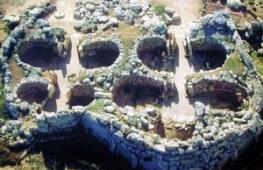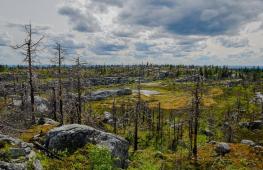Perforated lake in Portugal on the map. Lake with a hole in Portugal
Serra da Estrela(Serra da Estrela) are the highest mountains on mainland Portugal. The dam lakes located in these mountains supply the population of the region with drinking water and electricity. One of these reservoirs, called, at first glance seems the most ordinary. However, in a video taken by a drone and posted on the Youtube channel, you can see a strange round hole in the southern part of the lake, into which water is falling.
The hole looks like a piece of art created by nature. However, in reality it is the creation of human hands. You can admire it starting from the third minute.
As the Portuguese newspaper Diario de Noticias writes, we are not talking about a hole, but about a crater 4.6 m deep and 48 m wide. Under it there is a tunnel more than 1500 m long, through which excess water from this reservoir flows into the neighboring dammed lake - Lagoa Comprida (Lagoa Comprida). The structure, built in 1955, is a structural element of the Sabugueiro power plant in the Serra da Estrela Natural Park.
In this article you will learn about ten of the most unique natural waterfalls on our planet, whose unusualness and amazing origin is not only another confirmation of the richness of Mother Nature’s imagination and is a stunning sight, but also excites the minds of many scientists and researchers (as, for example, in case of the Devil's Cauldron waterfall).
So, put everything aside and plunge into the world of beauty and wonder!
10. Horsetail Fall, Yosemite National Park, California, USA
The water flow of the Horsetail Falls in winter and early spring flows down from Mount El Capitan, dividing into two separate streams and, falling down from a height of almost 500 meters and hitting the rocks, it is sprayed into a humid haze, continuing its 500 -meter-long path to the foot of the mountain.
In the last two weeks of February, it changes its hue, turning into a “fiery waterfall”. During sunset, the sun's rays are reflected in the falling water at right angles, creating a spectacular, albeit short-lived, effect that makes the waterfall look like a red-hot cascade of liquid fire.
9. Fog Waterfall, Djupadal, Iceland
A waterfall of mist cascading from a coastal cliff in Iceland was captured on camera in 2015 by Icelandic photographer Kjartan Gunnsteinsson.
The video shows how the fog cascades from the cliff into Dypidal and gently rolls towards the Breidarfjordur fjord. It is believed that this anomaly was caused by a temperature inversion, when rising warm air traps currents of cold air underneath it.
8. Horizontal Falls, Kimberley, Western Australia
There are only two horizontal waterfalls on the planet, and both are located deep in Talbot Bay in the Buccaneer Archipelago, located in the Kimberley region of Western Australia. This natural wonder consists of a pair of gorges in the McLarty Range.
Significant volumes of water are pushed through the gorges by powerful tidal waves, creating spectacular temporary waterfalls up to 5 meters high. The direction of water flow changes depending on the direction of the current.
During high or low tides, water accumulates between the gorges faster than it can flow through them. Massive water flows create a spectacular spectacle as water rushes through the gorges and down to the other side of the ridge line.
7. Bigăr Waterfall, Caraş-Severin, Romania
Although it is not impressive in its size or the volume of water flows, it is distinguished from all the others by its unique shape and location - an elongated rock covered with moss, hanging over the small Miniş River.
The waterfall is located exactly at the 45th parallel, exactly halfway between the equator and the North Pole, and is one of the most unique waterfalls on our planet.
6. Cameron Falls, Alberta, Canada
Cameron Falls is located in Alberta, Canada. If you happen to visit Waterton Lakes National Park in June, you will be lucky enough to see an extremely rare phenomenon in which Cameron Falls turns pink.
In the spring, heavy rains lift clayey rock called mudstone from the bottom. When light reflects off this mineral, the water takes on a beautiful pinkish-red hue.
5. Blood Falls, Antarctica
In the McMurdo Dry Valley in Antarctica, a bright red waterfall as tall as a five-story building flows from the Taylor Glacier into Lake Bonney.
Obviously, it was not real blood that gave the waterfall its name, but an underground lake 5 million years old. When the glaciers that formed at the surface of the lake began to freeze, the water at depth became salty.
When water from a subglacial lake seeps through cracks in the glacier, the iron-rich water comes into contact with the air and “rusts,” forming blood-red marks on the ice as it flows into Lake Bonney.
4. Underwater Waterfall, o. Mauritius
Okay, let's face it: technically this is not a waterfall off the coast of the Republic of Mauritius - it's just an optical illusion that makes it look like an underwater waterfall in the ocean.
As sand and silt, dispersed by waves in the depths, sink from one coastal shelf to another, much deeper, create a stunning .
3. Pamukkale, Denizli Province, Türkiye
Pamukkale (which means "cotton castle" in Russian) is located in the southwestern part of Turkey and has been a UNESCO World Heritage Site since the 1970s. Its famous terraces are formed from travertine, salt deposits from calcium-rich springs.
The amazing natural structure is 2700 meters long, 600 meters wide and 160 meters high. Pamukkale has been used as natural swimming pools for centuries. Even the ancient Greeks and Romans discovered the healing properties of the warm mineral springs that are located here.
The springs attract crowds of tourists here to not only experience their therapeutic properties, but also enjoy the splendor of the snow-white cascading reservoirs.
2. Devil's Kettle Falls, Grand Marais, Minnesota, USA
Devil's Cauldron Falls is a geological anomaly. On the north shore of Lake Superior, where the Brule River splits into two streams in Judge C.R. State Park. Magney, two waterfalls are formed, but this is not strange at all.
One stream of the waterfall flows into the river, and the other flows into... we just don't know where. No one has yet been able to figure out where this water goes. The researchers threw various objects into the stream, including ping-pong balls and even logs, and painted the water, but all in vain - neither paint nor thrown objects appeared either in the lake or anywhere else.
1. Ruby Falls, Chattanooga, Tennessee, USA
Ruby Falls is the deepest commercial limestone cave in the United States, as well as the most visited underground waterfall in the country (over 400,000 tourists per year).
The 44-meter waterfall was named after Ruby Lambert, the wife of the man who discovered it.
The water at Ruby Falls is high in magnesium, which means that if anyone were to drink enough of it, they would likely end up in the toilet for days (magnesium is a natural laxative). On such a funny note, we conclude the list of the ten most unique waterfalls on our planet!
There are many miracles in the world that are difficult to explain from a scientific point of view; they cause sacred awe in uninitiated people. These include UFOs or Bigfoot. But there are phenomena that are created by human hands, but look completely supernatural. These include a waterfall inside a lake in Portugal.
The beauty and mysteries of Portugal
This country is amazing and beautiful. Its climate is different from Europe, and its nature is amazing. Thousands of tourists come here to admire the local beauty. Thus, the mountainous part resembles a “rock garden” created by nature. During the Ice Age, boulders of varying sizes - from small to huge - were left lying on the slopes in a chaotic manner. Here you understand how omnipotent the forces of nature are. This view is so unusual that the flow of people wanting to see it only increases every year.
In addition, Portugal is a kingdom of rivers and lakes that are filled with the purest water from a melted glacier. They are connected to each other by multiple streams - both natural and man-made. This system of reservoirs allows you to control the water level.
Of course, Portugal has a rich history that is of interest to those who visit this country. But there is another stunningly beautiful place here that attracts not only curious tourists, but also lovers of the unknown and the supernatural, and even Satanists from all over the world.
Lake with a hole

Videos and photos of a waterfall inside a lake in Portugal are literally mesmerizing. On the completely flat Lake Conchos, suddenly, as if at the request of some unknown force, a whirlpool begins, the diameter of which is about fifty meters. The funnel literally sucks in tons of water. After a short time, she disappears, and the lake looks like a mirror again. Nothing reminds me of the past miracle...
A banal answer
Even the videos and photographs of this spectacle are mesmerizing. Many lovers of mysticism called this place a gate to the underworld or a portal to another world, but the true reason for this phenomenon is much more prosaic. Conchos - a lake with a hole in Portugal - is a technically complex man-made object, the result of human engineering genius. Many reservoirs are equipped with natural and artificial waterfalls to regulate the water level. Lake Conchos is one of them.

The perforated lake in Portugal is the creation of human hands. The giant funnel is an ingeniously designed mine spillway. A one and a half kilometer tunnel connects two lakes - Conchos and Lagoa Comprida. And into which the water goes is a receiving tank, the diameter of which is 48 m and the depth is 4.6 m.
When the water level in Conchos reaches its limit, the sluice opens and the water noisily goes into the funnel, creating a whirlpool. This spectacle does not leave indifferent even those who know the true reason for what is happening. Lake Conchos is an element of a local power plant located in the largest Portuguese park, Serra da Estrela.

This amazing thing was built back in 1955, but is still successfully operated today, supplying energy to the surrounding area.
The power of nature and human genius
The miracle of Portugal - a hole in the lake - has been overgrown with grass and moss over the years of use, which is why it looks like a natural object, and not created by human hands. From this, watching the water drain takes on some kind of supernatural and slightly sinister connotation. Many even endowed this place with mystical meaning.
Visit to the lake
Thanks to videos posted on the Internet, a waterfall inside a lake in Portugal is becoming increasingly popular among tourists. Many people want to see this spectacle with their own eyes. Those who want to visit the famous reservoir should wear waterproof clothing and shoes. And if the excursion takes place in winter, then don’t forget about thermal underwear and a thermos with hot tea.

A waterfall inside a lake in Portugal is an example of how a miracle created by human hands can not only become a useful engineering object, but also attract tourists. After all, you won’t see such a spectacle anywhere else.
This is how the mystery of this waterfall is simply solved. Ah, if all mystical miracles could find such a simple explanation, then life would be much simpler. But there is always a place for a miracle, even a man-made one.
Perforated lake in Portugal!
To be more precise, this is not a perforated lake in Portugal, but a mine spillway hole. A reservoir in Portugal is called a perforated lake. However, in addition to this leaky lake, other rivers and lakes in Portugal are also popular today.
Portugal is one of the most beautiful and tranquil countries on the Iberian Peninsula. Many tourists come to Portugal to enjoy the beautiful beaches of the Algarve, fine wines from Porto, and to experience the culture of big cities such as Aveiro and Lisbon. Lovers of secluded relaxation prefer to spend their holidays on the picturesque shores of reservoirs. This article will talk about the most popular lakes and rivers in Portugal.
1.
This beautiful river, according to locals, is one of the most popular in all of Portugal. The current of the Mondego is quite stormy, which means it is attractive for lovers of kayaking and canoeing.
2. Lake Pateira de Fermentelos(Pateira de Fermentelos).
Pateira de Fermentelos is one of the largest lakes in the entire Iberian Peninsula. Its coast attracts lovers of green tourism with its diverse flora and fauna.
Walking along the coast of Pateira de Fermentelos, you can spot ducks, butterflies, fish and frogs.
3. .
Caldeiran is located in the center of the Portuguese island of Corvo. The lake is very deep and cold. It is recommended to come to the lake to enjoy the rich wildlife on the coast, as well as try your hand at fishing.
4. .
The river forms the northern border with Spain. Steamship cruises along the Minho are very popular among tourists. The landscape that opens from the side of the ship is very beautiful. Without leaving Portugal, you can admire the cities of Spain. For pilgrims it is like mile zero.
5. Douro River.
The Douro River is ideal for yachting enthusiasts. Although the river is known for its dangerously fast current, small coasters, boats and yachts regularly navigate it. The most popular yacht route: Porto - upper Douro valley - Alto Douro wine region.
The Douro River, the second largest in Portugal, originates from the Iberian Islands. The Douro River is more than 200 kilometers long and ends at the Atlantic Ocean. Its surroundings are very picturesque, and the river valley is an ideal place for growing port wine grapes.
6.Guadiana River.
The river forms Portugal's eastern border with Spain. The Guadiana coast has a hot, dry climate that attracts summer beach lovers. The river flows into the Gulf of Cadia near the town of Vila Real di Santo Antonio. This port city is not very interesting for active tourists. Here you can visit shops selling fruits and vegetables brought from the villages, and also stroll along the huge marina for boats and yachts.
In the highest mountains of the mainland there is a miracle, which in advertising brochures is called “perforated”. Even the name itself sounds intriguing, and those who have seen photographs of the reservoir, when traveling to Portugal, certainly strive to visit this place and see with their own eyes the waterfall in Lake Conchos - one of the famous ones. It is a round hole in the middle of the water surface, through which water from the lake goes somewhere deep.
General informationIn fact, Lake Conchos is not a natural formation at all, but a man-made reservoir, and the waterfall in Lake Conchos is also not a creation, but a talented engineering solution, original and non-standard. Lake Conchos is a structural element of Sabugueiro.

The "waterfall" inside Lake Conchos in Portugal is simply a receiving reservoir into which water from the lake begins to flow when the control water level in the reservoir is reached. The diameter of the funnel is 48 m, and the depth is 4.6. There is a 1.5 km long tunnel under the lake, and excess water from it flows into Lagoa Comprida, a nearby “dammed” lake. is located in the southern part of the lake.
Finding Lake Conchos in Portugal on the map is not difficult: it is located almost clearly to the southeast from about 140-150 km, if you look in a straight line.
 How to get to the lake?
How to get to the lake?
There are a lot of people who want to see the “lake in Portugal with a hole,” so you can get here from Porto and other large cities. Those who wish to explore Lake Conchos on their own can travel from Lisbon by car. You should take the A1 highway or A1 and A23. In both cases, you will have to cover a little more than 300 km; the journey will take about 3.5 hours.



